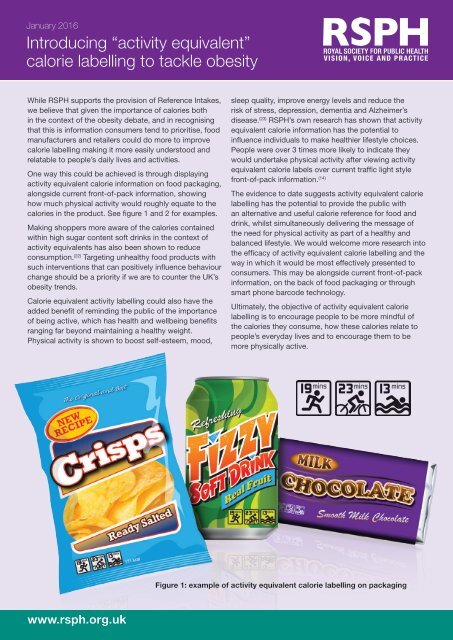Introducing “activity equivalent” calorie labelling to tackle obesity
activity_equivalent_calorie_labelling_paper_rsph
activity_equivalent_calorie_labelling_paper_rsph
Create successful ePaper yourself
Turn your PDF publications into a flip-book with our unique Google optimized e-Paper software.
January 2016<br />
<strong>Introducing</strong> <strong>“activity</strong> <strong>equivalent”</strong><br />
<strong>calorie</strong> <strong>labelling</strong> <strong>to</strong> <strong>tackle</strong> <strong>obesity</strong><br />
While RSPH supports the provision of Reference Intakes,<br />
we believe that given the importance of <strong>calorie</strong>s both<br />
in the context of the <strong>obesity</strong> debate, and in recognising<br />
that this is information consumers tend <strong>to</strong> prioritise, food<br />
manufacturers and retailers could do more <strong>to</strong> improve<br />
<strong>calorie</strong> <strong>labelling</strong> making it more easily unders<strong>to</strong>od and<br />
relatable <strong>to</strong> people’s daily lives and activities.<br />
One way this could be achieved is through displaying<br />
activity equivalent <strong>calorie</strong> information on food packaging,<br />
alongside current front-of-pack information, showing<br />
how much physical activity would roughly equate <strong>to</strong> the<br />
<strong>calorie</strong>s in the product. See figure 1 and 2 for examples.<br />
Making shoppers more aware of the <strong>calorie</strong>s contained<br />
within high sugar content soft drinks in the context of<br />
activity equivalents has also been shown <strong>to</strong> reduce<br />
consumption. (22) Targeting unhealthy food products with<br />
such interventions that can positively influence behaviour<br />
change should be a priority if we are <strong>to</strong> counter the UK’s<br />
<strong>obesity</strong> trends.<br />
Calorie equivalent activity <strong>labelling</strong> could also have the<br />
added benefit of reminding the public of the importance<br />
of being active, which has health and wellbeing benefits<br />
ranging far beyond maintaining a healthy weight.<br />
Physical activity is shown <strong>to</strong> boost self-esteem, mood,<br />
sleep quality, improve energy levels and reduce the<br />
risk of stress, depression, dementia and Alzheimer’s<br />
disease. (23) RSPH’s own research has shown that activity<br />
equivalent <strong>calorie</strong> information has the potential <strong>to</strong><br />
influence individuals <strong>to</strong> make healthier lifestyle choices.<br />
People were over 3 times more likely <strong>to</strong> indicate they<br />
would undertake physical activity after viewing activity<br />
equivalent <strong>calorie</strong> labels over current traffic light style<br />
front-of-pack information. (14)<br />
The evidence <strong>to</strong> date suggests activity equivalent <strong>calorie</strong><br />
<strong>labelling</strong> has the potential <strong>to</strong> provide the public with<br />
an alternative and useful <strong>calorie</strong> reference for food and<br />
drink, whilst simultaneously delivering the message of<br />
the need for physical activity as part of a healthy and<br />
balanced lifestyle. We would welcome more research in<strong>to</strong><br />
the efficacy of activity equivalent <strong>calorie</strong> <strong>labelling</strong> and the<br />
way in which it would be most effectively presented <strong>to</strong><br />
consumers. This may be alongside current front-of-pack<br />
information, on the back of food packaging or through<br />
smart phone barcode technology.<br />
Ultimately, the objective of activity equivalent <strong>calorie</strong><br />
<strong>labelling</strong> is <strong>to</strong> encourage people <strong>to</strong> be more mindful of<br />
the <strong>calorie</strong>s they consume, how these <strong>calorie</strong>s relate <strong>to</strong><br />
people’s everyday lives and <strong>to</strong> encourage them <strong>to</strong> be<br />
more physically active.<br />
Figure 1: example of activity equivalent <strong>calorie</strong> <strong>labelling</strong> on packaging<br />
www.rsph.org.uk


